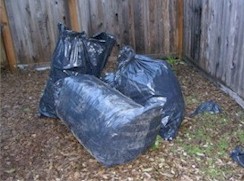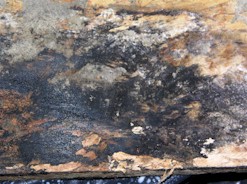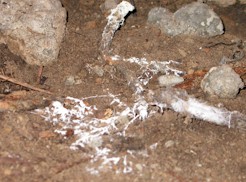At the mold seminar as well as in everything
I read, both online and in books, it was emphasized that
crawl spaces need to be absolutely dry, ergo sealed, and
that ventilation is needed in the attic because heat rises. There
are gorgeous illustrations in some of these books explaining
the movement of both air and moisture in a building.
Due to this information, I decided to begin my mold remediation
in the crawl space. A very savvy realtor recommended
the CleanSpace system so I am inviting you to join me
on a tour of my project . . . day-by-day as the system
is installed.
No one really needs to know
what my issues are: all that is needed is an
understanding of what is required to fix a problem. This
starts with eliminating moisture and whatever the
mold can use for food.
|
First, turn the calendar back
a year when the inspector and mold tester assessed the problems
and issued a formal
report. I discussed this in the account of
my mold odyssey. He made recommendations which were
to be used by others to develop a protocol for remediation. Part
of his recommendations pertained to the crawl space where
he discovered some irregularities, which I will not discuss
in detail because this is fodder for the lawyers.

The beginning of remediation
entails removal of all organic material in the crawl space:
this includes every scrap of wood left by contractors and
even nails because, as we remember, rust is
also a kind of fungus.
|
What
was found under my new house filled five contractor's
black bags (only four shown on this picture)!
|
| |
One of the crucial
things the inspector had recommended was the removal
of the framing materials around the concrete supporting
the posts. This is very important and maybe the
safety goggles sitting on the concrete suggested that
someone intended to come back and do this, but he forgot. |
|
The part of the framing material
that was hidden by the visqueen. |
 |
|
In addition to these
terrible pieces of board, there were a lot of other
scraps, nails, twigs, roots, and odds and ends of building
materials, all accidents waiting to happen—and
happen they did. |
 |
|
The rest of what was found under
the house is probably a normal part of Nature, but
still undesirable. For instance, there were salamanders
and their eggs, very odd mushrooms, and several kinds
of mold, including the white one on this photo. |
Crawl
Space Remediation, the next day 
Ingrid Naiman
15 November 2005




Installation
of Crawl Space Encapsulation || CleanSpace Installation
A-Z
CleanSpace
Installation A-Z || Garage || Air
Pressure
Remediation
Attire || Duct Cleaning || Particulates || Mold
Dog

Copyright by Ingrid Naiman
2005
No part of this site may
be reproduced or published in any form or on any other web
site without written
permission from the site owner.








